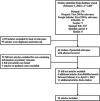Otologic and vestibular symptoms in COVID-19: A scoping review
- PMID: 35599837
- PMCID: PMC9111077
- DOI: 10.1002/wjo2.57
Otologic and vestibular symptoms in COVID-19: A scoping review
Abstract
Background: Otologic and vestibular symptoms have been seen in patients confirmed to have COVID-19 disease. Further discussion of these symptoms may provide insight into short- and long-term management for these patients.
Objective: The aim of this review was to describe the otologic and vestibular symptoms that present in patients with COVID-19. The primary outcomes of this review were onset, duration and clinical outcomes of these symptoms.
Sources of evidence: Pub Med, APAMed Central, Herdin, CINAHL, Scopus, Springer Link, ProQuest Coronavirus Research Database, and Google Scholar were searched for the articles to be included.
Eligibility criteria: Studies included were those involving adult patients diagnosed with COVID-19 who experienced hearing loss, ear pain, ear discharge, otitis media, vertigo, or tinnitus. Studies were eligible for inclusion if there was a description of the otologic dysfunction, specifically onset, duration, or clinical outcomes.
Results: The majority of patients who experienced hearing loss (68%), tinnitus (88%), vertigo/dizziness (30%), ear pain (8%), and discharge (100%) did so within a month of experiencing the typical symptoms of COVID-19. A majority also experienced complete resolution of their symptoms within 2 weeks. Standard treatment for COVID-19 was usually provided but when specific diagnoses are made for these symptoms (e.g., sudden sensorineural hearing loss, otitis media, vestibular neuritis), they are treated in the same manner as one would for non-COVID-19 cases, in addition to the management for COVID-19. In certain cases, there may be a need for additional work-up to rule out other causes.
Conclusions: Otologic and vestibular symptoms were present in COVID-19 patients, majority as part of the systemic nature of the disease. The onset, duration, and course were consistent with the natural history of a systemic viral infection. COVID-19 should be considered in any patient with a new-onset hearing loss, tinnitus, or vertigo/dizziness, even in the absence of infectious or respiratory symptoms.
Keywords: COVID‐19; dizziness; hearing loss; tinnitus; vertigo.
© 2022 The Authors. World Journal of Otorhinolaryngology ‐ Head and Neck Surgery published by John Wiley & Sons Ltd on behalf of Chinese Medical Association.
Conflict of interest statement
The authors declare no conflicts of interest.
Similar articles
-
Hearing Loss, Tinnitus, and Dizziness in COVID-19: A Systematic Review and Meta-Analysis.Can J Neurol Sci. 2022 Mar;49(2):184-195. doi: 10.1017/cjn.2021.63. Epub 2021 Apr 12. Can J Neurol Sci. 2022. PMID: 33843530 Free PMC article.
-
A review on the impacts of COVID-19 on the auditory system: Implications for public health promotion research.Health Promot Perspect. 2023 Dec 16;13(4):280-289. doi: 10.34172/hpp.2023.33. eCollection 2023. Health Promot Perspect. 2023. PMID: 38235010 Free PMC article. Review.
-
Characterization of otologic symptoms appearing after COVID-19 vaccination.Am J Otolaryngol. 2023 Mar-Apr;44(2):103725. doi: 10.1016/j.amjoto.2022.103725. Epub 2022 Dec 5. Am J Otolaryngol. 2023. PMID: 36525812 Free PMC article.
-
Otologic dysfunction in patients with COVID-19: A systematic review.Laryngoscope Investig Otolaryngol. 2020 Nov 17;5(6):1192-1196. doi: 10.1002/lio2.498. eCollection 2020 Dec. Laryngoscope Investig Otolaryngol. 2020. PMID: 33365394 Free PMC article. Review.
-
Audiological and vestibular symptoms following SARS-CoV-2 infection and COVID-19 vaccination in children aged 5-11 years.Am J Otolaryngol. 2023 Jan-Feb;44(1):103669. doi: 10.1016/j.amjoto.2022.103669. Epub 2022 Oct 20. Am J Otolaryngol. 2023. PMID: 36283164 Free PMC article.
Cited by
-
Analysis of characteristics of and risk factors for otological symptoms after COVID-19 infection.PLoS One. 2024 Feb 1;19(2):e0297100. doi: 10.1371/journal.pone.0297100. eCollection 2024. PLoS One. 2024. PMID: 38300969 Free PMC article.
-
An online survey on clinical characteristics of otologic symptoms linked to COVID-19 infection.Front Public Health. 2023 May 26;11:1184262. doi: 10.3389/fpubh.2023.1184262. eCollection 2023. Front Public Health. 2023. PMID: 37304124 Free PMC article.
-
Increased Incidence of Vestibular Disorders in Patients With SARS-CoV-2.Otol Neurotol Open. 2024 Apr 2;4(2):e051. doi: 10.1097/ONO.0000000000000051. eCollection 2024 Jun. Otol Neurotol Open. 2024. PMID: 38919767 Free PMC article.
-
Clinical Profile and Outcome Analysis of Ear-Nose-Throat Symptoms in SARS-CoV-2 Omicron Subvariant Infections.Int J Public Health. 2023 Oct 10;68:1606403. doi: 10.3389/ijph.2023.1606403. eCollection 2023. Int J Public Health. 2023. PMID: 37920846 Free PMC article.
-
Acute labyrinthitis: a manifestation of COVID-19 in a teenager.BMJ Case Rep. 2023 Dec 28;16(12):e258290. doi: 10.1136/bcr-2023-258290. BMJ Case Rep. 2023. PMID: 38154869
References
Publication types
LinkOut - more resources
Full Text Sources
Research Materials


